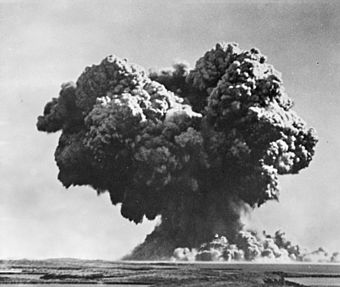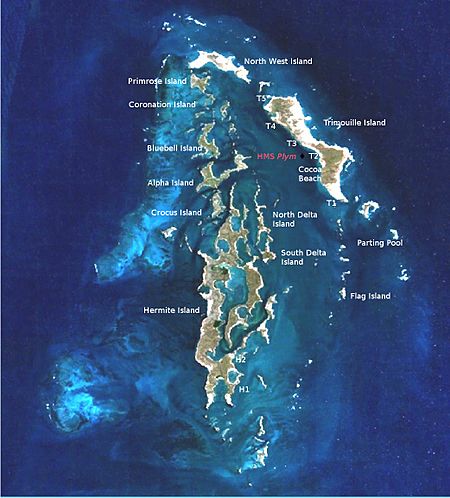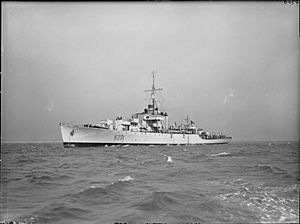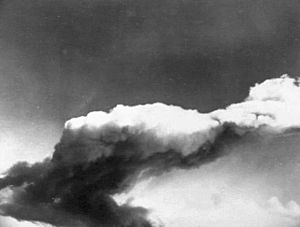Operation Hurricane facts for kids
Quick facts for kids Operation Hurricane |
|
|---|---|

The mud-laden cauliflower explosion
|
|
| Information | |
| Country | United Kingdom |
| Test site | Monte Bello Islands, Western Australia
|
| Date | 23:59:24 UTC 2 October 1952 |
| Number of tests | 1 |
| Test type | barge |
| Max. yield | 25 kilotons of TNT (100 TJ) |
| Navigation | |
| Next test series | Operation Totem |
Operation Hurricane was a very important event for Britain. It was the first time they tested their own atomic bomb. This powerful bomb, made with plutonium, exploded on 3 October 1952. It happened in the water near the Montebello Islands in Western Australia. After this successful test, Britain became the third country in the world to have nuclear weapons. The United States and the Soviet Union were the first two.
During World War II, Britain started a secret project called Tube Alloys to build nuclear weapons. But in 1943, they joined forces with the American Manhattan Project. Many smart British scientists helped the Americans. After the war, the US government stopped sharing nuclear secrets with Britain. In 1947, British leaders decided they needed their own atomic bombs. They worried about America becoming isolated and Britain losing its important global status. This new project was called High Explosive Research. Lord Portal led the project, and William Penney was in charge of designing the bomb.
Contents
Why Britain Needed a Bomb Test
Britain knew that if they built an atomic bomb, they would need to test it. They first hoped to use a test site in the Marshall Islands, which was controlled by the US. They also thought about sites in Canada and Australia. The British Navy suggested the Monte Bello Islands in Australia might be a good spot. So, the British Prime Minister, Clement Attlee, asked the Australian Prime Minister, Robert Menzies. Australia agreed in May 1951. In February 1952, the new British Prime Minister, Winston Churchill, announced that the first British atomic bomb test would happen in Australia that year.
The Test Fleet and Bomb Assembly
A small group of ships was put together for Operation Hurricane. Rear Admiral A. D. Torlesse was in charge. The main ship was the HMS Campania, an escort carrier. Other ships included the LSTs Narvik, Zeebrugge, and Tracker. Leonard Tyte was the technical director from the Atomic Weapons Research Establishment.
The bomb was put together (without its radioactive parts) at Foulness Island in Britain. Then, it was taken to the frigate HMS Plym to be sailed to Australia. When the British ships reached the Monte Bello Islands, eleven Royal Australian Navy ships joined them. This included the aircraft carrier HMAS Sydney.
Testing a Ship-Smuggled Bomb
The British were worried about an atomic bomb being smuggled into a port on a ship. To test this, they exploded the bomb inside the hull of the Plym. The ship was anchored about 350 metres (1,150 ft) away from Trimouille Island. The explosion happened 2.7 metres (8 ft 10 in) below the water. It left a big, round crater on the seabed. This crater was 6 metres (20 ft) deep and 300 metres (980 ft) wide.
Choosing the Test Site
The discovery of nuclear fission in 1938 made scientists realize that a super powerful atomic bomb could be made. During World War II, British scientists like Otto Frisch and Rudolf Peierls figured out that a small amount of uranium-235 could create a huge explosion. This led to Britain's atomic bomb project, called Tube Alloys.
Joining Forces with America
In 1943, British Prime Minister Winston Churchill and US President Franklin Roosevelt signed an agreement. This agreement combined Britain's Tube Alloys project with America's Manhattan Project. Many British scientists worked on this joint effort. They helped with different parts of bomb development. James Chadwick led the British team at the Los Alamos Laboratory. He worked closely with Leslie R. Groves, the head of the Manhattan Project.
After the war, the special relationship between Britain and the US changed. Britain thought America would keep sharing nuclear technology, but the US passed a law, the Atomic Energy Act of 1946, that stopped this. This law prevented the US from sharing secret information with its allies.
British Prime Minister Clement Attlee then set up a special committee in 1945. This committee decided that Britain needed its own nuclear weapons program. Lord Portal was put in charge of producing atomic energy. An Atomic Energy Research Establishment was set up to do research. William Penney was chosen to lead the bomb development. He believed that having an atomic bomb showed a country was a "first-class power."
Finding a Test Location
Since Britain didn't have large, empty areas for testing, they looked overseas. Their first choice was the American Pacific Proving Grounds. But in 1950, the Americans said no. So, Britain looked at sites in Canada and Australia.
A study listed what was needed for a test area:
- It had to be isolated, with no people living within 100 miles (160 km) downwind.
- It needed to be big enough for many tests over several years.
- Winds had to blow fallout out to sea, away from ships.
- Temporary and main camps needed to be far upwind from the explosion.
- It had to be ready by mid-1952.
The British Navy suggested the Montebello Islands in Australia. These islands are about 80 kilometres (50 mi) and 130 kilometres (81 mi) from Onslow, Western Australia. Prime Minister Attlee got permission from Australian Prime Minister Robert Menzies to send a survey team.
Australia and Britain had strong ties. Most Australians had British roots, and many British people were moving to Australia. Their soldiers also fought together in the Korean War and the Malayan Emergency. Australia was also interested in developing atomic energy because it had little oil or coal.
A survey team arrived in November 1950. They used HMAS Karangi to map the waters and collect samples. The Royal Australian Air Force (RAAF) took aerial photos. The team found the islands suitable for testing, but only in October due to the weather.
Negotiations continued with the Americans about using their test site. However, security concerns arose when it was revealed that a British official, Donald Maclean, had been a spy. This made the Americans less willing to share secrets.
In December 1951, Britain decided to use the Monte Bello Islands. On 26 February 1952, Prime Minister Churchill announced this in the House of Commons. He joked about the impact on local animals, saying the survey team only saw birds and lizards. However, a biologist on the team, Frank Hill, actually found over 400 species, including new insects and plants.
Getting Ready for the Test
To organize "Operation Hurricane," the British government set up a special committee. An Australian committee was also created. A key question was who could watch the test. Churchill decided no media or UK politicians could attend. Canadian scientists could see all technical data, but Australians could not.
William Penney wanted Ernest Titterton, an Australian scientist who had worked on US nuclear tests, to help. Prime Minister Menzies agreed to let Titterton work on the project. Other Australian scientists also joined as observers.
Building the Camps
An advance team from the RAAF's No. 5 Airfield Construction Squadron arrived in Onslow in August 1951. They brought heavy equipment to the Monte Bello Islands. They built a prefabricated hut and a weather station. Roads and camp sites were also built.
More work began in February 1952. The RAAF flew more construction workers to Onslow. Materials like Marston Mat for roads and hardstands were brought in. A water supply system was also set up. Pipes were brought from Sydney and the Woomera Rocket Range to bring water from the Fortescue River to the islands.
The British fleet for Operation Hurricane included the HMS Campania (the main ship) and three LSTs. Leonard Tyte was the technical director. The Campania carried helicopters and small boats. The bomb, without its radioactive parts, was put together at Foulness Island. It was then loaded onto the frigate HMS Plym on 5 June 1952. The journey took eight weeks because they sailed around Africa to avoid unrest in Egypt.
The Monte Bello Islands were reached on 8 August. The Plym was anchored in 12 metres (39 ft) of water, 350 metres (1,150 ft) off Trimouille Island. The radioactive parts of the bomb, the plutonium core and neutron initiator, were flown in by air. The British bomb design was similar to the American Fat Man bomb. It had a special "levitated pit" design that made the explosion more powerful with less plutonium.
Eleven Australian Navy ships joined the British fleet. This included the HMAS Sydney aircraft carrier. A law was passed to make the area around Flag Island a prohibited zone for safety. Australian ships patrolled this area and provided support. RAAF planes also flew air patrols and courier runs.
The Operation Day
The main control site, called H1, was on Hermite Island. This is where the bomb would be set off and monitored. Cameras that could take 8,000 pictures per second were set up. More monitoring equipment was on Trimouille Island, closer to the explosion. This included gauges to measure the blast and pressure. Scientists also used empty petrol tins to measure the blast, a method used in earlier American tests. They also studied how the explosion affected paints, fabrics, and plants.
Challenges and Adjustments
Scientists were supposed to stay on the Campania and travel to the islands daily. But the tides were misjudged, and the Campania couldn't enter the lagoon. Transferring to smaller boats in choppy waters was dangerous. Rough seas also made it hard to work. Travel between ships and islands took a long time. To solve these problems, tent camps were set up on Hermite Island and Trimouille Island for the scientists.
Scientific practice runs were held in September. A full rehearsal happened on 19 September, after the radioactive bomb parts arrived. William Penney arrived on 22 September. Everything was ready by 30 September, waiting for good weather.
The weather improved on 2 October, and Penney set the test date for 3 October. The final countdown began at 7:45 AM local time. The bomb exploded successfully at 7:59:24 AM on 3 October 1952. The explosion happened 2.7 metres (8 ft 10 in) underwater. All that was left of the Plym was a "gluey black substance" and a few pieces of metal. The bomb worked exactly as planned.
Helicopters collected samples of contaminated seawater. Scientists in protective gear collected samples and recordings. Air samples were taken by RAAF planes. The islands were very radioactive. It was clear that an atomic bomb exploding in a British port would have very serious consequences. The fallout cloud went out to sea as planned, but later blew back over the Australian mainland. Very small amounts of radioactivity were found as far away as Brisbane.
Penney and some staff returned by air on 9 October. Penney was honored for his role in Operation Hurricane. The Royal Navy ships left the Monte Bello Islands on 31 October. Most scientists returned to Britain by plane. The rest returned on the Campania.
What Happened Next
Two more nuclear tests, part of Operation Mosaic, happened in the Monte Bello Islands in 1956. By the 1980s, the radioactivity had mostly gone away, making it safe for visitors. However, some radioactive metal pieces from the Plym remained. The islands were a restricted area until 1992.
A survey in 2006 found that the wildlife had recovered. A special type of legless lizard discovered by Frank Hill was not extinct. In 2009, rats and feral cats were removed from the islands. Birds and marsupials were brought from nearby Barrow Island. Today, the Monte Bello Islands are a park. Visitors are told not to spend too much time at the test sites or take souvenirs.
Studies of people involved in the British nuclear tests did not find clear evidence of increased health problems. A 2006 study of Australian participants showed a small increase in cancer, but this was linked more to sun exposure than radiation from the tests.
Operation Hurricane made Britain the third nuclear power. The first production bombs, based on the Hurricane design, were delivered in 1953. Four weeks after Operation Hurricane, the US successfully tested a hydrogen bomb, which was much more advanced. Because of this new technology, the US government saw no reason to restart nuclear cooperation with Britain. Even though Operation Hurricane was a success for Britain, it didn't lead to the closer nuclear partnership with the US that Britain had hoped for.
Summary
| Name | Date and time | Location | Elevation + height | Delivery, purpose | Device | Yield | Fallout | Notes |
|---|---|---|---|---|---|---|---|---|
| Hurricane | 23:59:24 2 October (UTC) 07:59:24 3 October (AWST) |
Monte Bello Islands, Western Australia 20°24′27″S 115°33′14″E / 20.407445°S 115.554013°E | 0–2.7 m (0.0–8.9 ft) | Barge, weapon effect |
British Blue Danube design, levitated pit | 25 kt | Unknown | Exploded in the hull of HMS Plym |
- Better quality extract from the same video of the Hurricane Nuclear Test
See also
 In Spanish: Operación Hurricane para niños
In Spanish: Operación Hurricane para niños







